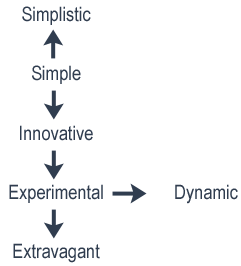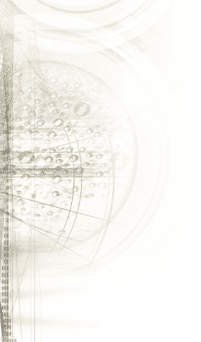
Multimedia
Design 3 - Design Styles
Whether designing a website, interactive multimedia CD-ROM or kiosk application,
you will need to choose a design approach or style for your application.
This style will need to consider the audience type, their needs and the
objectives of the application.
These design styles fit into 5 broad categories as illustrated in the
diagram below.

At the top of the tree, is simplistic design. At the other end is extravagant
work, which is the design opposite to the simplistic approach. Simplistic
work results from under use of elements while extravagance is the over
use or over design of work. Extravagance can result from an experimental
approach gone wrong or by a lack of innovation and understanding of the
relevant issues relating to the project. Between simplistic and extravagant
design are design approaches of varying degrees of innovation. The innovative
approach moves beyond simple work through a higher degree of inventiveness
and the incorporation of a narrative as discussed in the
Narrative Design article.
Simplicity vs Simplistic
Designing for simplicity involves achieving the main objectives in an
uncomplicated, uncluttered and straightforward way. This results in minimal
distraction or confusion. Simplistic design is an over simplified approach.
It occurs when you do not consider all the issues in an attempt to avoid
any problems.
You may see a design style on a website that you decide to implement in
your own work. If you copy the style exactly without customising it to
your unique purpose, your work can appear simplistic. This is because
the design does not include an understanding of your own specific needs
and requirements.
An example of simple design is roxx.com.
The front page uses 2 colours and minimal graphic elements. Contrast is
achieved by colour. The buttons have horizontal alignment; the overall
composition has asymmetrical balance. It is clear how to interact with
this page and where the buttons will take you when clicked. There is careful
thought about negative space. Although there are not too many graphic
elements, there is a clear grouping of related items.
My site (the one you’re in now) is simple in design. It is clear,
easy to use and accessible to visitors who have little experience in the
use of multimedia or web navigation.
Innovative
Innovation involves inventing ideas or using techniques in new and unique
ways. It is being imaginative and experimental with bold ideas. You can
be innovative with navigation, animation or even image manipulation and
placement in a scene. Innovation makes your work more interesting, exciting,
entertaining, simply more fun to view and use, and thereby increasing
the impact and effectiveness of the work.
Innovation can also be achieved through the use of narratives and navigational
metaphors as discussed in the Narrative Design
article.
Examples:
Andy Foulds, Aaco
Tech
Experimental
Experimental design is about testing new ideas on the chance of success.
It looks to discover a new way to communicate. When experimental work
succeeds, projects can be exciting and dynamic.
While innovative work involves imaginative thought and some degree of
experimentation, experimental work goes a step further. It involves breaking
rules in the hope that the result will be more successful.
The more you experiment with new ideas, the more risky your work becomes.
Design resulting from higher degrees of experimentation can be more complex
to read, understand and even use. However, they can also become much more
powerful.
Dynamic work can be a result of successful
experimentation. Dynamic work contains energy and movement. You can create
the illusion of movement by image placement and direction, which provide
cues to draw the viewer’s eyes across the screen.
Examples:
K:E:I:C:O:N,
Juxt Interactive
Extravagant
While simplistic is one extreme, extravagance is the other. Extravagant
design is unsuccessful due the over design of a scene. It could be the
result of adding too much colour, too much contrast or too much of any
other design element. Extravagance can result from experimentation gone
wrong, or it could be due to a lack of innovation and simply a lack of
understanding of design.
All design should have some degree of experimentation and innovation.
The key is not to overdo your work. You should always take a short break
while designing as this clears your mind and lets you see your work from
a fresh perspective.
If you have any feedback on this article, feel free to let us know at:
feedback@multimediacreative.com.au
©
2003 Multimedia Creative
